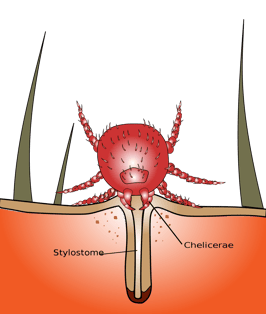Home2
What Are Chiggers?
Chiggers are the tiny, immature stage of a large mite called a redbug. These colorless, parasitic larvae measure only 1/150 of an inch in diameter, but they pack a punch with their itchy bites throughout summer, not letting up until the fall.
You’ll find chiggers wherever there is unmanaged vegetation. They crawl around, waiting to attach to a host. Birds, livestock, snakes, rodents and other animals are their natural hosts. Humans are accidental hosts.
Life Cycle of Chiggers
Two to three generations of chiggers are produced each year. They favor damp areas with low-growing shrubs, grass and weeds. Once on a human host, they crawl upward until they find an area where clothing fits tightly against the skin, such as waistbands, bra bands and socks. Then they settle in and feed. Their favorite feeding spots are the backs of knees, the crotch and in the armpits.
To feed, chiggers pierce the host’s skin with their mouthparts and inject a digestive enzyme that dissolves the skin tissues. The chigger then sucks up the dissolved epidermis as food. As they feed, the tissue around the bite hardens into a tiny tube. For three to four days, the chigger continues sucking liquefied tissue through the tube, much like a person drinking through a straw. The chigger never burrows into the skin and does not feed on blood.
Even though the chigger mite is usually scratched off and killed soon after biting, the tiny hardened tube and the digestive enzymes stay in the skin. They continue to itch and to ooze the liquefied tissues, which dry to form a hardened cap. Over a few weeks, the skin heals and the bites go away.
How To Get Rid of Chiggers
Chiggers are a huge nuisance that can make spending time in your backyard miserable. By setting up pest treatment and maintaining a pest control strategy, you can take back your yard from chiggers.
Contact us today to discuss your options and set up an appointment!
